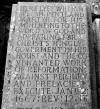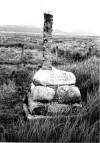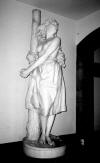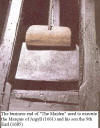|
Execution
Property,
which was sometimes substantial, was usually forfeit to the Crown when a
Covenanter was executed, and if they had a coat of arms it would be rent
and thrown down by the Lyon King of Arms. A consequence was that families
would be cast out of their home to spend their life in poverty or relying
on charity of friends. Such was the case of John Nisbet who was
executed 4 December 1685 “and his lands, goods and gear to be
forfeited to the King`s use “
The
method of execution adopted by the authorities were many and often
excessively cruel. The main method for execution of the Covenanters was by
hanging, usually in the Grassmarket, Edinburgh which is on the south side
of the old city below the castle and just a few yards from the Greyfriars
Kirk where the bodies were buried. For very many years the slopes of
Castle Hill was the usual location for executions and the Grassmarket was
regularly used from about 1681 onwards. The Town Council in fact appealed
to Parliament against the decision saying
” said Grassmercat is now absolutelie
necessar for want of other places to be mercat for pitch,tarr,
grasse,herbs, horse, nolt,sheep and other things which can be exposed
to sale in no other place” and that
“His Majestie and his Ministers having taken
from us the south bank of the Castle of Edinburgh, which was the ordinaire
place for publicke executions of malefactors, we have no other place
besides this grasse mercat for any such execution.”
Here
sometimes there were two scaffolds erected. One was to support the ladder
which the prisoner climbed and sat upon the top rung, he might say a few
words and pray until the napkin was put over his face, and then he would
be `turned off ` the ladder. The second scaffold was for the` hagging off`
of the head, and sometimes the hands and arms, of the prisoner when
ordered that they be placed on show as a warning to the populace. The
special or higher class of prisoner, the Marquis of Argyll and David
Hackstone for example, were executed at the Mercat Cross.
Hackstone`s
hanging, drawing and quartering was very specifically prescribed by the
Privy Council. It is believed that it was the first case where the body
(torso) was actually quartered. Hitherto the practice in Scotland had been
to sever the limbs at the joints, leaving the torso intact for burial.
Thomson
in The Martyr Graves of Scotland quotes the Court`s judgment..
….. to be drawn backwards on a hurdle to the
Mercat Cross and there: at the cross of Edinburgh, and there upon a high
scaffold erected a little above the cross have his right hand struck off
and after some time to have his left hand struck off, and then to be
hanged up and cut down alive, and the bowels taken out, and his heart to
be shown to the people by the hand of the hangman, and his heart and
bowels to be burnt in the presence of the people, in a fire prepared for
that purpose upon the scaffold, and afterwards to have his head cut off,
and his body divided into four quarters, and his head to be affixed on the
Netherbow, and one of his quarters with both of his hands to be affixed at
St. Andrews, another quarter at Glasgow, the third at Leith, the fourth at
Burntisland, and that none presume to be in mourning for him, nor he to
have a coffin, and that none be on the scaffold with him but two baillies,
four officers, the executioner and his servants, and this sentence to be
put in execution against him this thirtieth day of July instant, betwixt
three and five o’clock in the afternoon. And ordained his name, fame,
memory; and honours to be extinct, and his arms to be riven and delete
furth of the books of arms, so that his posterity may never be able to
bruick [hold] or joyse [enjoy] any lands, heritage, titles of dignities
within this realm in time comming.
 
Grassmarket Memorial, Edinburgh.
1. The plate bearing the names of those executed in the Grassmarket.
2. Memorial Garden.
In Edinburgh the gate most used for
exhibiting the Covenanter heads was the Netherbow Gate at the end of
Canongate. The location of the original gateway is shown today by brass
cobbles set into the street surface. It was usual for the executioner to
cut off the head and hold it aloft with the cry `here is the head of a
traitor`. Sometimes arms and hands would be sent to the prisoner’s home
town for nailing to the church door as a warning to others. Ten prisoners
executed after the battle of Rullion Green were dealt with this way
despite having shown quarter. Others, such as William Welsh of Dumfries,
were sent for
 execution execution
and exhibition in their home towns.

Ministers of the Covenant usually had their heads affixed
over the gate on a spike and their hands pointed mockingly in prayer
beneath. The heads would often remain above the gates for many years.
That the
executions were spectacles there can be no doubt. For the inhabitants of
Edinburgh it was probably the only time they saw people they may have only
previously heard of. When Hugh McKail was executed on 22 December 1666
there were five others who were hung at the same time – Humphrey
Colquhoun, Mungo Kaip, Ralph Shiells, John Wodrow; and John Wilson.
Donald Cargill on the other hand was quite philosophical about his
execution, telling a lady visitor while in prison not to worry as they
could ” knit me up;cut me down and chop off my old head, and then fare
well, they have done with me and I with them for ever.”
At the
executions of John King and John Kid the latter turned to his companion
and quipped
” I have often heard and read of a
`kid` sacrificed, but I seldom or never heard of a ` King` made sacrifice.
“
Surprisingly
John Howie`s The Scots Worthies does not include one of the most
celebrated executions of the Covenanter pantheon – the executions by
drowning of the Solway Martyrs, Margaret Wilson aged 18 and Margaret (Mc)Lachlan
aged 63. Margaret Wilson, her sister and brother were the wilful children
of Gilbert Wilson. They declined to adhere to the established church with
their parents and were followers of James Renwick. Margaret and her 13
year old sister were captured but the younger girl was released after her
father gave a £100 bond. Margaret Lachlan was simply a pious widow who was
`seized off her knees, reading her bible` because she was Presbyterian.
Both refused to take the Abjuration Oath and were sentenced to death by
drowning. The method of execution by drowning was specifically prescribed
for women by order of the Privy Council only a short while before they
became the sufferers. Thus the judge sentenced them to
be:
” ty’d to palisados fixed in the sand,
within the flood mark, and there to stand till the flood overflowed them
and drowned them.”
The women
were tied to stakes below the high water mark and drowned at Wigtown on 11
May 1685.
 
The grave of the Wigtown Martyrs, and the Marker Post memorial on the shore
or `merse`.
A much earlier execution was that of Mrs Robert Lamb of
Perth. She was convicted by the priests of refusing to pray to the Virgin
Mary while in childbirth, and her husband convicted of interrupting a
friar who was preaching that man could not be saved without praying to the
saints. Robert Lamb was executed by hanging and his wife tied in a sack
and drowned.

The Margaret Wilson Statue,
Knox College, Toronto.
Nobility
and Kings were usually executed by having their heads chopped off. In
England it was the block and the axe that was used, which could be a quick
death if the blow was clean and done with one sweep. But it could also be
messy such as with Mary Queen of Scots, for whom three sweeps of the axe
were necessary to decapitate her. When the executioner came to hold her
head aloft he dropped it, as it fell out of her luxurious wig to expose
her thin grey hair beneath.
In
Scotland there was a guillotine, called `the Maiden`, which can been seen
today in the Museum of Scotland, Edinburgh. It is of note that the device
pre dates the use in the French Revolution. The Halifax Gibbet as it was
called,had its first recorded use ca
1286 and the last in 1650, between which dates 53 men and women were
executed using the device.
 The The
Maiden was introduced to Scotland
during the minority of King James VI, from Halifax, West Yorkshire, in the
north of England, by the Regent James Douglas, 4th Earl of Morton. The
Earl was eventually executed by it himself, although contrary to legend he
was not the first person to be executed by it. From 1564 to 1708 when it
was withdrawn from use, over 150 people were executed on the maiden.
The stout wooden frame supports a heavy
steel blade which made no mistake when it fell.
Lead weights weighing around 75 pounds (34 kg) were
attached to the axe blade.Thus suffered the
Marquis of Argyll on 27 May 1661.He was later followed on the block by his
son, the 9th Earl, who was executed 30 June 1685.
Hanging,
drawing and quartering was a particularly cruel death that seemed to be
reserved for the bravest of the brave who by their actions had been a
particular problem. David Hackstone of Rathillet was certainly both brave
and a troublesome Covenanter. Hackstone featured large in most of the
battles and attended notable Declarations. He was at Bothwell Brig and
Ayrsmoss, but he was also with the band who murdered Archbishop Sharp on
Magus Moor. Although he took no actual part in the killing he was the
senior man present and no doubt was sentenced to be hung drawn and
quartered for his involvement. On the 24 July the privy Council met and
made arrangements for the arrival of Hackston, turning the matter into a
gala event for the public. Hackston was mounted bare back on a white
horse, facing backwards with his feet tied tightly beneath the horse, and
hands tied behind him. He was preceded by the hangman bearing the head
and hands of Richard Cameron on his halberd as a standard; and three other
prisoners tied to the horses tail. Thus on display the prisoners were
taken to the Cannongate Tolbooth.
On 30
July 1680 the execution of David Hackston took place: drawn on a hurdle to
a high scaffold, right hand severed; an interval; the left hand severed;
body drawn up to the top of the gallows several times, dropped alive;
heart cut out and thrown down, spitted with the hangman holding aloft the
still beating heart of Hackstone on knife point and calling out “Here is
the heart of a traitor“ The heart was then burnt .Afterwards the body was
decapitated, and cut up, the head was set up at the Netherbow Gate
alongside that of his friend Richard Cameron; one quarter and the hands
sent to St Andrews, and other quarters to Glasgow, Leith and Burntisland
for display and warning to others.
The only
other member of the assassins of James Sharp to be caught and executed was
Andrew Guilline. He was caught by a suspicious curate when he refused to
answer questions about attending church. Apprehended at Cockpen on 11
June 1683 he was quickly brought to trial and sentenced to die, first to
have his hands struck off, then hanged, beheaded and his body to be hung
in chains at Magus Moor. On 20 July 1683 the sentence was carried out,
allegedly by a drunken hangman who took nine blows to sever the hands
which were exhibited with the head above the Netherbow Port. His
disembowelled body was taken down by friends after a couple of months.
They were discovered, however, and sentenced to banishment for `owning`
the Archbishop`s murder.
Glasgow
was the scene of the execution of friends, James Smith and John Wharry.
They had the misfortune to be in the vicinity of Inchbelly Bridge when
some Covenanters attacked soldiers escorting prisoners to Glasgow. In
the attack a soldier, David Murray, was killed and another wounded. Smith
and Wharry were discovered in nearby Stevenson Wood, neither armed nor
acting furtively. They were seized, taken to Glasgow and convicted on
suspicion alone. They were taken to Glasgow Cross, hanged on a gibbet till
half dead, then cut down and taken by cart to Inchbelly Bridge where they
were hung in chains.
The
shooting of Covenanters for refusing to take the Abjuration Oath was
central to the Killing Time when so many gained the Martyr`s Crown. This
was the height of the persecution of the strict Covenanters – the
Cameronians and followers of James Renwick. The Killing Time was mainly in
1685 and seemed to coincide with the death of King Charles II in February
1685 through to the accession of his brother as James VII/II. It also
coincided with the threats of rebellion in Scotland led by the Earl of
Argyll who opposed the Catholic successor, James, and saw the opportunity
to restore his fortunes that had been forfeited in 1681. In England there
was fear of rebellion led by Robert Scott, Duke of Monmouth. However, the
shootings virtually stopped from 1686 with about two only in 1686 and two
in 1688. The last Covenanter to be shot was a 16 year old boy, George
Wood, of Sorn in June 1688 by a trooper John Reid, who it appears, thought
it the thing to do at the time.
18/07/2011
|